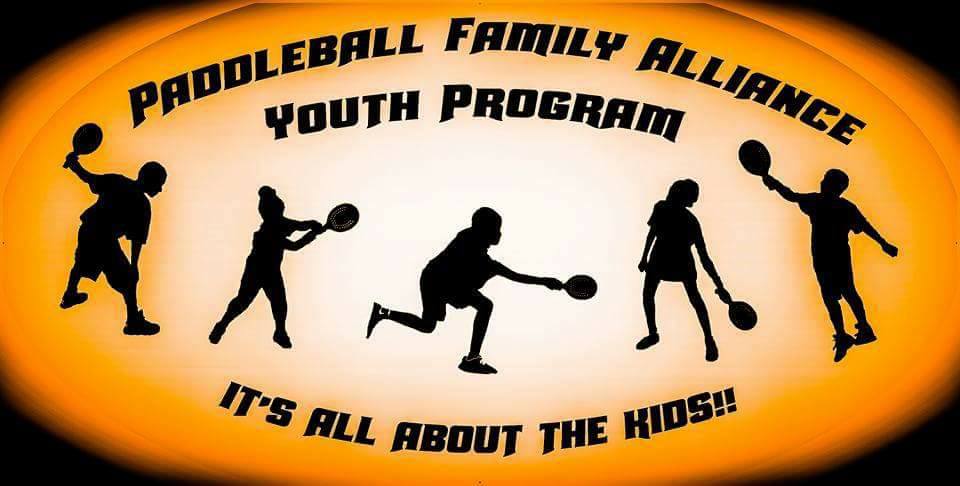
by Eddy Cabrera | Mar 26, 2018 | Legend of the Game, Weekly Player Profile
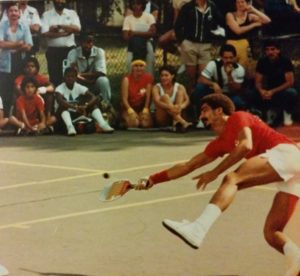
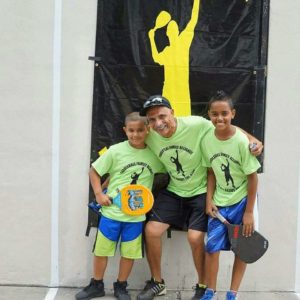
Mike Melendez Paddleball Player Profile No-36 by Dave Siegel
The Paddleball Family Alliance has inducted two greats into its Hall of Fame: Howie Hammer and John Bruschi. Everyone will agree that both are well deserving of this honor, but who should be next? You could make a case for several legends, but there is one player who must get major consideration because he actually qualifies twice! Mike I and Mike II. The paddleball world is well aware of Mike II, who is a present day top doubles player and the most significant contributor to the game since Mr. Paddleball, Howie Hammer. Without Mike’s tireless work during the past five years, the sport likely would have continued its downward spiral, but instead it is in the midst of a remarkable rebirth. But it occurred to me that some of today’s players may not be totally familiar with Mike I, who played in the golden age of paddleball and is the most dominant singles player ever.
Mike Melendez was born in the Dominican Republic and came to the United States at the age of fourteen, settling in the Bronx. He started out playing handball at Ogden Park and eventually transitioned to paddleball. One day a short time later, on his way to a Yankee game at the Stadium, as he passed the adjacent paddleball courts, Mike noticed a large crowd was gathered. They happened to be watching a paddleball tournament finals match and he stopped by to take a look. For the first time, he observed what paddleball played at a high level was like and loving what he saw, he immediately decided this is where he had to be. So Mike went back to Ogden and doing what he does best, he put in hours and hours of practice time. When he felt he was ready to move up to a higher level, he went back to the Stadium, but much to his chagrin, he was frozen out of the good games by the cliquish players. This fueled his desire to succeed even more and he persisted of course, and in a short time, he made it into the “A” game and eventually took great glee when he beat them all!
Throughout his life, he has had an intense desire for excellence and to strive for success. It is obvious that to him the only way to achieve his goal is through hard work and dedication. He didn’t get to be a great player with only his natural talent. Why singles? He now says that he gravitated to the singles game because he was in control of the court, not relying on a partner, and unlike present day, singles was big-time back then. He also loved (and still does) to practice his game without a partner. His training regimen is legendary, spending long hours perfecting his repertoire of shots. Back in his heyday, he would play or practice five hours a day, every day. Realizing that the angle serve was a great weapon in singles, Mike would place a can of soda in the corner by the short line, aimed for it with serve after serve, and actually hit it often. It also helped that he was a tennis fan and the great singles player Bjorn Borg was his sports idol. Mike Melendez went on to dominate the singles game during paddleball’s golden age, highlighted by winning six of seven Budweiser singles titles from 1980 to 86.
What type of player is Mike Melendez? He was (and is) a very offensive player, relentlessly attacking the ball using great angle shots and jams to put his opponent on the defensive, setting up his deadly put-away kill shots. But he is also a complete player who enjoys playing defensively. His motto is “Play the ball, do not let the ball play you.” Back in the 80s, Mike played paddleball with all his heart and soul, his life centered around the game, feeling that it would become his career. With the half million or so players in the tri-state area, major sponsorship in site, Mike says that he truly believed that paddleball was about to propel to a national game and become the next major sport. But, sadly, this was not to be.
In 1987 Mike took a “brief” 25 year hiatus. He took up a new sport: marathon running. As we all know, distance running requires intense training and Mike was surely not adverse to that. He ran ten marathons, finished them all, achieving a best time of 3:11. He also took up tennis, and became a “pretty good” player (his words). I bet he’s better than pretty good.
How did Mike II come to be? In 2012, he happened to stop by Van Cortlandt Park and watched some paddleball, and as he says, “a fire ignited inside me.” Also, he had become plagued by an ailing knee and had come to realize that covering a large tennis court was not the greatest idea. So Mike decided it was time for his paddleball comeback. Now living in New Jersey he, of course, practiced and practiced by himself near his home and when he felt he was ready, he returned to the game. Now a part of paddleball again, Mike took a step back and didn’t like everything he saw. Most of the players at the courts were playing racquetball, not paddleball. But the worst was that everyone was old! Where were the young adults and the kids? It’s great that older people played paddleball, but Mike knew the game would die out if there was not a big infusion of youth. And then it hit him: Paddleball was a great sport back in the 70s and 80s, but the key to its decline was that we forgot to invest in the youth! Mike was determined that we don’t make that mistake again!
In 2013, with the same dedication and hard work that defined Mike’s youth, he formed the Paddleball Family Alliance and it became a great vehicle to promote the game, attract players back to paddleball and most importantly get the youth to take up the game and stick with it. From the start, he knew that he would need lots of help along the way and turned to his trusted paddleball friends like Hoppy, Mitch, Kathy and Ray S. and they did not let him down. As the rolling snowball grew, many others have volunteered their time to further the cause. Knowing that money would be paramount to getting things done, he set up the PFA as a legitimate non-profit organization, which facilitated the recruitment of business sponsorship as well as individual donations. And indeed there has been strong financial support. Obviously, communication was key. He formed the Facebook group and web-site and used other social media outlets that became important in spreading the word. In order for paddleball people to get to know each other better (as in Paddleball Family), Mike organized get-togethers of players across the tri-state area (PowPows) and fostered the paddleball profile program. He addressed the thorny issue of inappropriate behavior on the court with a new Code of Conduct and made sure the PFA held the players accountable. Knowing there were still gaps and ambiguities in the rules, Mike organized the update of the rulebook and continues to communicate it. Mike always felt tournament competition was one of the keys to growing the game and the PFA has sponsored many successful tournaments. But, unquestionably the cornerstone of the PFA is the youth program: the successful kids clinics, the kids exhibitions at tournaments, and in the pipeline, the introduction of paddleball into the NYC high school system. And don’t forget the PFA slogan: “It’s all about the kids!” Speaking to Mike now about children in paddleball, it’s obvious where his passion is. He just loves teaching and helping kids improve their lives through paddleball. Even if there was no paddleball, Mike would for sure be involved in youth programs and teaching.
What about Mike Melendez, the person? He is a proud family man, with his beautiful wife, Maggie, three grown-up children and three grandchildren. He says he’s retired, for now… What does that mean? In the past, he has played many other sports besides paddleball, tennis and running marathons, including baseball, basketball, bowling and speed skating. But now, it’s pretty much paddleball, which he now plays twice a week. He’s also a celebrity. During the era of his singles dominance, Mike starred in a Budweiser commercial. No, he was not guzzling a brew, he was playing paddleball! Unfortunately, as much as we’d like to see it, Mike says it’s unavailable. But he can tell us all about it and how it almost never came to be.
What does Mike feel is most important for the sport to continue its upward spiral? It’s addressing the most significant factors in paddleball’s downfall after the 1980s. First, people must get involved by volunteering their time in one way or another in mentoring the kids and keeping them interested. Secondly, it’s setting the example of good sportsmanship and to support the efforts to make it part and parcel of the sport. Also we have to accept that the big-ball game has emerged and has overtaken the traditional small-ball. Though Mike loves the speed of small-ball, the big ball is easier to control and the game is more spectator-friendly because the rallies are longer. But at the end of the day, “It’s all about paddleball!”
Mike Melendez has become paddleball’s leader and inspiration. He has this message to everyone involved in the game today: “I want to thank all of my peers that are volunteering their time and energy in promoting our beloved sport of paddleball. Together we can do it. The future of paddleball is looking great!” Mike Melendez, You Got Next!
by Mike Melendez | Feb 3, 2018 | Legend of the Game, Weekly Player Profile

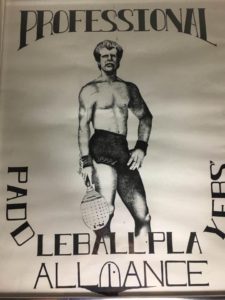
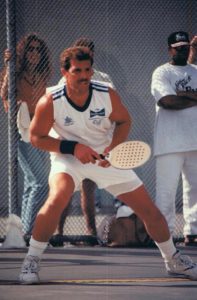
Donnie Ciaffone Paddleball Profile by Mike Melendez
The decade of the 1980s marked the Golden Years of paddleball as the sport’s popularity skyrocketed across the five boroughs of New York. Many of the public parks were producing budding stars. At Bay 8th Street in Brooklyn a 16 year old kid named Donnie Ciaffone was attracting much attention and the word spread across the city. Donnie was gifted with superior athletic talent, chevalier social skills, and a unique, almost “rock star” presence. Yes! At Bay 8th Street the sport of paddleball was shaping its next star!
Donnie was born in Brooklyn and started playing paddleball at the age of 15 at a small park on Avenue S in Bensonhurst. Eventually he was looking for tougher competition and took his game to Bay 8th, which became his home park. Donnie recalls, “While coming up in the sport at Bay 8th a great legend named Caesar Polichetti took me under his wing and taught me discipline, technique and how to use my left hand. I then met another legend, Rochelle Weiner Martinez, who introduced me to the games played across the city.” Donnie became one of the best players at Bay 8th, his deadly game dominated by extraordinary power and incredible spikes. The spike was his favorite shot, which he hit to all angles of the court, but yet his game was guided by a smooth, graceful glide. He made the game look so easy.
Donnie took on all comers at Bay 8th for 15 years, while competing in tournaments across the tri-state area. Donnie and Rochelle teamed up for many tournaments and won several championships, including two Budweiser mixed doubles. Mixed doubles was closest to his heart and he loved playing with Rochelle and at times they were unstoppable. Donnie was also an early proponent of women’s equality in paddleball. Ray Gaston, the president of the Professional Paddleball Players Association, the organization of paddleball’s Glory Days, said, “Ciaffone was one of the first paddleball super-stars to actively lobby for greater women’s participation in the sport. In an era when women players were not taken as seriously as they are today, Donnie often challenged other male greats to play more mixed doubles. “Let’s hear it for the ladies!” was his cry. This stance, coupled with his dashing stature, earned him icon status and his image was incorporated into the PPPA logo.” Paddleball legend, Anita Maldonado said, “There are real marriages and then there are mixed doubles marriages in paddleball. One of those special unions was Donnie Ciaffone and Rochelle in the 1980s. They dominated one-wall mixed doubles like no other team. What makes a great mixed doubles team? The most important ingredient is an awesome player like Donnie Ciaffone. He was athletic, smart and he was hard hitter. He always fought for position and used his partner as a pick. His height enabled him to have the best spike in the game. When Donnie spiked the ball, he spiked it out of the park! He was tall, blonde and boy was he handsome! Although he was not as dominant in men’s doubles as he was in mixed, Donnie will go down as one of the best players of the 1980s!”
At the age of thirty, Donnie moved to the Bronx where his game matured as he faced fierce competition. Donnie recalls, “In the Bronx I was spanked and taught by players like Anthony Fiorino, Robert Cheilli, Ralph Capogrosso, Craig Ruiz, Bobby Fiorentino, Fernando Frias and Mike Melendez.” Speaking for myself, I teamed up with Donnie for a number of years and I can personally say he was humble and gentle by nature, but everyone knew when Donnie was in the park! Whether at an elite private beach club against other top ranked players or in a local urban tough neighborhood park against lower-level ranked players, it didn’t matter, the man was there to play!
Present day, Donnie lives in Florida and plays about twice a month at Hollywood Park. He would like to play more, but like many of us, the game he played for so many years has resulted in his body taking a beating, and it has taken its toll. “After spinal surgery, and having both knees replaced, my paddleball game just isn’t what it used to be.” He has taken up pickleball, which is the sport he now mostly plays because it’s much easier on his body.
On the personal side, Donnie has this to say about his life today: “I live with my wonderful, beautiful wife Neda. She is my world. I love to play pickleball and I love to fish. Living in Florida makes this very accessible to me. As far as food goes, I’m a meat and potatoes guy and I love an occasional martini. Most of us think that it’s all about winning, but it’s not. The friendships, the physical exercise and family union are what’s most important.”
How does Donnie feel about the paddleball game today? “I think paddleball has grown in diversity with the different balls that are presently played. I love the fact that there are now young players in the game and what the Paddleball Family Alliance is doing with the clinics is remarkable. Thank you Mike for that. My advice to young players is to pace yourself and to play only when you’re healthy. I have seen what can happen first-hand by overplaying. I believe paddleball is on the right track and I wish it would spread nationally.”
“When we consider One Wall “Legends,” few in paddleball come larger than Donnie Ciaffone!” – Ray Gaston
by Mike Melendez | Jan 5, 2018 | Legend of the Game, Weekly Player Profile

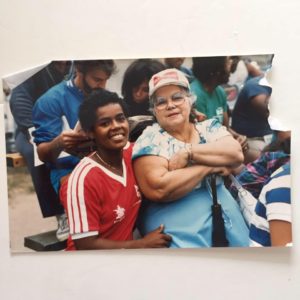

Anita Maldonado Paddleball Player Profile by Dave Siegel
The magnificent award-winning profile photo says it all. We see the acrobatic athletic ability, her skill, and most importantly, the never-give-up determination. And yes, Anita Maldonado made the shot! And it was a killer!
The 1980s was the golden age of paddleball, with an estimated 440,000 men, women and children of all ages playing this urban New York City game. There were many excellent players, but far and away, the most accomplished woman player was Anita Maldonado and she might very well go down in history as the best woman paddleball player ever. Anita won an incredible eight out of nine Budweiser women’s singles titles from 1981-89. In 1992 she played in her last singles tournament, again winning the Bud Classic and it was in the finals that Anita made the fantastic, historic, diving shot.
Like many paddleball players, Anita started out playing handball. For her it was at the local courts at 108th St. and Park Ave. in Spanish Harlem, where she grew up. She says that the instant she first picked up a paddle, she was attracted to the sport and soon was playing every day. Eventually Anita moved to Central Park, followed by the Yankee Stadium courts and finally she settled in at Carmine Street, where she played for many years as her home park.
Anita did not become great by just playing the game and having fun. She put in long hard hours practicing, training, and working on her endurance. With her intelligence and mental toughness, combined with hard work, she knew that she could rise to the top in paddleball, and indeed she did. One person who played a very significant role in Anita’s paddleball career was Aubrey Nelson. Aubrey, who Anita described as a “paddleball intellectual,” and “like a father to me,” was her coach and mentor throughout her tournament days. He imparted great wisdom and helped transform her into a complete player, featuring stamina, quickness and power. Another person who had a tremendous inspirational effect on her life was her late mother, who was her number one fan and attended all of her tournaments.
Anita’s game was highlighted by power, combined with smarts. She could spike it and could jam her opponent as very few women were capable of. Why did Anita gravitate to singles? She now says that striving to excel in singles truly drives a player to become dedicated to working out, staying in shape, learning the game and playing it correctly. Anita says this commitment made her feel grounded. She feels doubles is a much easier game, not requiring the same level of preparation or physical fitness. She would like to see the present paddleball revival movement add singles to the tournament schedule, and indeed, the PFA is on the mark by hosting a successful tournament last September and planning to do others in 2018.
With Anita, it was not all about her. As she became more accomplished, she gave back to paddleball, becoming an inspiration and mentor to many players. During her championship years, Anita and Mike Melendez teamed up with Budweiser and the NYC Parks Department, conducting numerous, very successful clinics across the tri-state area that helped get even more people involved in the flourishing game of paddleball.
In the late 80s Anita sought to conquer a new sport, taking up racquetball. But this extraordinary athlete did not just dabble in the sport. As with paddleball, she gave it her all, and rose to the highest echelon. Anita competed in the Pan American Games and won medals in the Central American Games, including the gold in 1998, for which she is honored in a museum in Puerto Rico. She became a racquetball professional and was ranked in the women’s division as high as the number four player in the world!
Presently, Anita plays (and excels in) racquetball in all its forms: four, three and one wall. In the past year she has resumed playing paddleball and returned to tournament competition. She plans to continue in 2018. She notes a big shift to the big ball game, especially over the past year or two. Her mindset now is that she sees all these racquet/paddle sports melding together, and she will train for, and compete in any of them.
When Anita is not playing sports, she loves to watch tennis and basketball. Nadal and LeBron are her favorite players. She also cooks a mean yuca and eggplant with cod fish!
by Mike Melendez | Dec 7, 2017 | Legend of the Game, Weekly Player Profile


John Bruschi Paddleball Player Profile by Howard Hammer
The consummate professional and the ultimate team player. Those are the words that come to mind when describing John Bruschi. In the 1960s and 1970s, I had the pleasure and great fortune of having John as my doubles partner, and I could not have asked for a better partner on the court. The success we were fortunate enough to enjoy was due to how well we worked together, and that success would never have been possible without John. Our partnership continued into the 1980s, as we and Marv Rosenberg and Howie Solomon put on exhibitions throughout the tri-state area and beyond, spreading our love of the game.
John was always recognizable on the court, with his familiar eye protection and helmet. Although not the fastest player or the hardest hitter, his amazing success came from the neck up: John was one of the smartest and best defensive players in the game. He was often a step or two ahead of his opponents, setting up shots and never giving in. His trademark lob shot would leave our harder hitting opponents bewildered. Perhaps the best thing that one partner can say about another is that “he made me look good.” John always made me look good. I can still remember like yesterday his defensive play. John was never out of position, and he never “hung me out to dry.” Victory after victory, and championship after championship was his paddleball legacy.
People that remembered John playing can recall the greatness and effortlessness with which he played. I was lucky enough to be witness to it day after day, and tournament after tournament. John also never rested on his laurels. I can recall John calling me in the middle of winter to practice, and I’d tell him I’m not sure we should because it’s 30 degrees out! But that was John, whose dedication to the craft, and always striving to get better, is another one of his qualities.
So too was his class, and the always respectful way he conducted himself on the court. As our competitive days were winding down, the next great doubles team of Andy Krosnick and Bobby Schwartz had the good fortune to compete against John and witness his play, and they continued to uphold the mantle of John’s skill and class.
I’ve known John for a half century, and I am honored to have played with him and learned from him. Most importantly, I’m proud to call him a friend. I’m glad he is remembered as one of the greatest paddleball players of all time.
by Mike Melendez | Oct 31, 2017 | Legend of the Game

Howard Hammer Biography by John Bruschi
Howard Hammer is the first inductee into the PFA Hall of Fame, and rightfully so. He was not only one of the greatest players the game has ever seen, but he also contributed more to the game than anyone I know. No one else is more associated with paddleball than Howie. Therefore, the title “Mr. Paddleball ” is really appropriate.
I met Howie in the 1960’s when we both participated in Chris Lecakus’s U S Paddleball Tournaments. Howie was outstanding, winning championships in both singles and doubles. He was a great offensive player, making killers from almost any angle. We teamed-up in 1969 and went on to win the American Paddleball Association championships from 1969 to 1972. We retired shortly thereafter in order to play in the touring exhibitions.
However, more importantly for the sport was Howie’s contributions off the court. He wrote the first book on paddleball strategy called “Paddleball: How to play the game.” He designed a good looking paddle called “The Hammer”, which was very popular and had record sales. He promoted and sold single Paddleball wood walls to many clubs and parks. He eventually became president of the American Paddleball Association (APA) and for many years ran some of the best tournaments the game had seen. He helped popularize the sport with his tireless efforts to promote the game wherever he went, on and off the court.
But, it would be fair to say that the greatest accomplishment Howie made was to bring the sport to the people of the greater N Y region by promoting the touring exhibitions. From Pennsylvania to Connecticut, from Long Island to Staten Island, from the Catskills to the Jersey shore and a lot of places in between, people were able to see some of the finest players of the era, such as, Tom Terrific, Howard Solomon, Whitey Faber and Marvin Rosenberg. Of course, Howie was key to the group’s success. A fabulous entertainer and public speaker, he engaged and delighted the audiences wherever he went.
For me, it has been a tremendous experience and honor to be associated with Howie, a true professional, and I am happy to say that our friendship continues to this day.
by Mike Melendez | Oct 27, 2017 | Legend of the Game

Andy Krosnick Legend of the Game By Bobby Schwarz
Andy Krosnick, legend (and remarkably still among the top players) of the game. Andy Krosnick is one of the most unique player to have ever competed in the game of One Wall Paddleball. In Andy’s case, I have to comment in the past; and strangely enough, I have to speak about the (hard to believe) skills that he possesses to this day.
Growing up in the Rockaways, Andy played all sports. I remember playing on a Police Athletic League Baseball team with Andy. We were probably twelve or thirteen years old. He was as fierce a competitor then as he is now. As Andy grew older he focused most of his athletic attention to Paddleball. At Beach 17th Street, in Far Rockaway, we had our home courts. Those courts were actually a training camp. We had unbelievable games there on a daily basis in the 1970’s, 1980’s and years after. It was like a tournament every day. Andy was that one guy that could drive you crazy. He returned anything and everything you could possibly hit at him. Andy had(and has) two great hands, deceiving power, clutch shot-making ability, a never give up attitude(even if you’re down 19 to 9 in a finals, a game we won) and the ability to make gets that only Andy(The Fly) can.
As most followers of Paddleball know, Andy and I teamed up to be (excuse me if I sound arrogant) the team that all other teams were measured against. Andy was the perfect partner, competitor and sportsman. He was always simply there to cover my sometimes overly aggressive play. He would make ridiculously difficult returns look easy; and he would crash into fences or dive across the pavement (Lenny Dykstra like) to return opponent’s best shots, and ultimately win the point.
Here is a flashback: In one particular tournament our opponent had hit a hard, head high shot up the middle. I decided to leave it for Andy, maybe a mistake. Andy, caught by surprise, in a move any contortionist would be proud of, manages to move his arm behind his back, get his paddle above his shoulders, leap up and forward, and return the ball that was actually past him. The return softly and barely hit the wall, but was a kill shot. I never saw anything like this. Nobody ever did. Probably never will. All in a day’s work for Andy.
Andy was the best paddleball doubles partner I ever played with. We won many, many titles together. His greatness undeniably contributed immensely to my paddleball career. I can’t thank him enough for his commitment to our team, and our years of friendship. Andy gave and continues to give much of his time to every aspect of the game. He was a co-founder of the Paddleball Players Association. He promoted and directed various tournaments in New York and in Florida. Oh, by the way Andy continued to play and compete in open tournaments. I have been away from the scene for quite some time, but I know that Andy Krosnick and Robert Sostre have won several Open Paddleball Tournaments. Forget age; Andy is ageless! He is an absolute legend. I had the pleasure of competing alongside Andy for many years. Robert Sostre has benefited from teaming up with Andy in the current era of paddleball. The entire paddleball community should thank this great player and great man, Andy Krosnick, The Legend, for just being Andy. Andy, my partner, my friend, I thank you. Let the Legend Live On!














Recent Comments